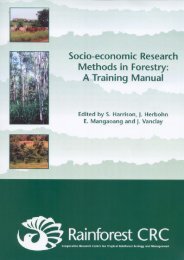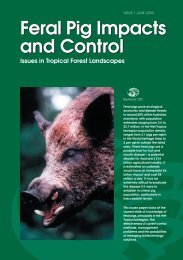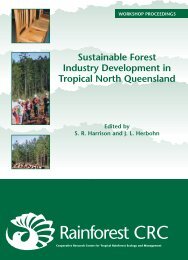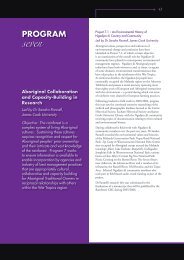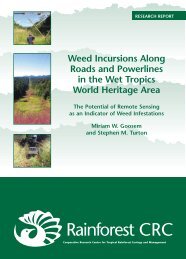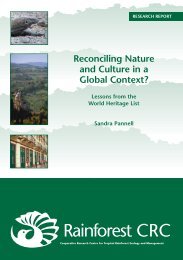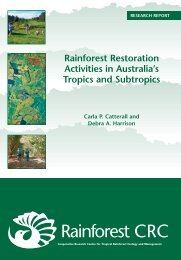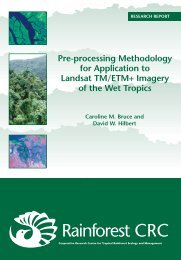Reconciling Nature and Culture in a Global Context? - Rainforest ...
Reconciling Nature and Culture in a Global Context? - Rainforest ...
Reconciling Nature and Culture in a Global Context? - Rainforest ...
You also want an ePaper? Increase the reach of your titles
YUMPU automatically turns print PDFs into web optimized ePapers that Google loves.
<strong>Reconcil<strong>in</strong>g</strong> <strong>Nature</strong> <strong>and</strong> <strong>Culture</strong> <strong>in</strong> a <strong>Global</strong> <strong>Context</strong>?Lessons from the World Heritage Listpoach<strong>in</strong>g’ issue, the plan also identifies local burn<strong>in</strong>g of grassl<strong>and</strong>s on the isl<strong>and</strong> of Komodoas a threat to the Komodo monitor <strong>and</strong> its primary prey species.Notwithst<strong>and</strong><strong>in</strong>g the considerable impact of the 1977 management plan upon the localhuman communities with<strong>in</strong> <strong>and</strong> adjo<strong>in</strong><strong>in</strong>g the National Park, the plan portrays a somewhatconf<strong>in</strong>ed view of nature, albeit one regarded as ‘out of balance’, focused upon the ‘dragon’<strong>and</strong> its terrestrial habitat. In keep<strong>in</strong>g with the plan’s objective to restore nature to itsbalanced state, it appears that at the time of the World Heritage list<strong>in</strong>g <strong>in</strong> 1991 on-groundmanagement activities <strong>in</strong> the Park were largely devoted to law enforcement <strong>and</strong> the provisionof guided tourist facilities (WCMC 1994). While Komodo National Park was listed as aBiosphere Reserve <strong>in</strong> 1977, the implications of this different read<strong>in</strong>g of the environment wasnot readily apparent <strong>in</strong> the Park until the early 1990s. At this po<strong>in</strong>t <strong>in</strong> time, not only wasnature redef<strong>in</strong>ed (once aga<strong>in</strong>), but it was also privatised <strong>in</strong> the process. It is apparent thatthese changes were largely driven by the World Heritage list<strong>in</strong>g of Komodo National Park<strong>and</strong> grow<strong>in</strong>g <strong>in</strong>ternational concerns about the loss of nature <strong>in</strong> the Park.UNESCO’s ‘Man <strong>and</strong> the Biosphere Programme’, launched <strong>in</strong> 1970, signalled a new globalvision of nature <strong>in</strong> terms of the idea of ‘biodiversity’ <strong>and</strong> the need to halt the loss of it.Paradoxically, the discourse of biodiversity is l<strong>in</strong>ked to globalisation <strong>and</strong> the rise of corporateenvironmentalism (se Katz 1998) 27 . As Luke observes, by the 1970s the Enlightenment ideaof ‘nature’ as “untouched <strong>and</strong> undisturbed expanses” appeared obsolete, <strong>in</strong>deed, ‘dead’(1995: 12). In draw<strong>in</strong>g public attention to the impact of humans on nature <strong>in</strong> the form ofwholesale ext<strong>in</strong>ctions, “<strong>in</strong>dustrial pollution, greenhouse gases, chemical contam<strong>in</strong>ation, <strong>and</strong>radioactive wastes” (Luke 1995: 12), science played an important role <strong>in</strong> br<strong>in</strong>g<strong>in</strong>g about the‘end of nature’ (McKibben 1989).In a world no longer replete with unexplored regions, where historically science pushed theborders of the unknown, <strong>and</strong> confronted with the reality that few, if any, environments wereundisturbed, nature has undergone an ‘<strong>in</strong>volution’ (Katz 1998: 46).Natural spaces have been reworked to produce greater ‘<strong>in</strong>ternal sub-divisions’ (loc. cit.).Biodiversity, biosphere reserves, biodiversity ‘hotspots’ <strong>and</strong> bioprospect<strong>in</strong>g are some of thediscursive <strong>and</strong> material products of this redef<strong>in</strong>ition <strong>and</strong> <strong>in</strong>volution of nature. Accord<strong>in</strong>gly,conservation efforts have shifted from an emphasis upon nature as a quantity (i.e. untouchedexpanses ‘hoarded’ for their “prist<strong>in</strong>e appearances <strong>and</strong> organic presences”) to focus<strong>in</strong>g uponthe ‘quality of nature’ <strong>in</strong> terms of biodiversity, <strong>and</strong> the idea of rare or endangered flora <strong>and</strong>fauna.Ra<strong>in</strong>forests <strong>and</strong> reefs are among the many ‘hotspots’ <strong>in</strong> the world where the biodiversitybattles are be<strong>in</strong>g waged <strong>and</strong> won or lost depend<strong>in</strong>g on one’s position <strong>in</strong> the matrix ofrelations <strong>in</strong>volved <strong>in</strong> the production <strong>and</strong> preservation of nature. As Katz po<strong>in</strong>ts out, the rise of‘biocentrism’, where<strong>in</strong> nature is viewed as a biodiversity bank, among other th<strong>in</strong>gs, has seenthe resurgence of ‘preservation’ as a means of protect<strong>in</strong>g these public ‘assets’ (1998: 48).Various state <strong>and</strong> national <strong>in</strong>struments, together with <strong>in</strong>ternational conventions, such as theWorld Heritage Convention, are employed to secure these valuable resources for futuregenerations. In the ‘new nature’, constant scientific surveillance is necessary to survey,<strong>in</strong>ventory <strong>and</strong> guard the ecological values of these diverse but threatened spaces (Luke2003: 14, 19).The establishment of more than 480 biosphere reserves s<strong>in</strong>ce 1974 is one of the ‘ma<strong>in</strong> l<strong>in</strong>esof action’ adopted by UNESCO to m<strong>in</strong>imise biodiversity loss. From the 1970s onwards the27 The pursuit of diversity with<strong>in</strong> the context of globalisation is not conf<strong>in</strong>ed to the earth’s biota. AsLechner <strong>and</strong> Boli po<strong>in</strong>t out, globalisation was also seen as a ‘threat’ to cultural diversity (2005: 135).29




